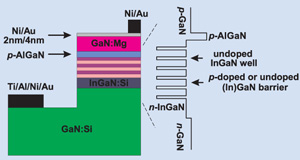
| Home | About Us | Contribute | Bookstore | Advertising | Subscribe for Free NOW! |
| News Archive | Features | Events | Recruitment | Directory |
| FREE subscription |
| Subscribe for free to receive each issue of Semiconductor Today magazine and weekly news brief. |
News
2 October 2008
Fathoming efficiency droop in InGaN MQW-LEDs
Researchers at Virginia Commonwealth University led by professor Hadis Morkoç have carried out experimental investigations to understand the ‘efficiency droop’ phenomenon that hampers the use of multiple quantum wells (MQWs) in creating high-brightness LEDs (Xie et al, App. Phys. Lett. vol.93, p121107, 2008, 22 September issue). The researchers believe that the problem arises from the difficulty that the heavy-mass holes have in navigating the MQW structure. The upshot is that they believe that only the top well has any significant level of photon emission, making the remainder of the quantum wells effectively inoperative.
The use of MQWs is an approach to overcoming the problems of producing traditional high-brightness GaN-based LEDs by increasing the thickness of the single undoped active layer, where the holes and electrons recombine to emit photons. Unfortunately, thicker-layer double heterostructure devices are difficult to produce with suitable properties and sufficient quality for efficient photon emission. Rather than one thick layer of doubtful quality, MQWs have a number of thin high-quality active layers. The problem with MQW GaN LEDs is that the external quantum efficiency (EQE) drops off as the current density increases – and hence the efficiency 'droops' for light output.
An added complication in producing GaN LEDs is that the material used to create p-type material with holes as majority carrier is Mg. Where Mg is present, electron-hole recombination tends to be non-radiative (i.e. no light). Hence undoped active layers are used.
To investigate efficiency droop, the researchers created five blue-light-emitting InGaN MQW structures, with the aim of testing their ideas on impeded hole transport in the structure (Figure 1).

Figure 1: Schematic of multi-quantum well (MQW) LEDs.
The first had undoped GaN barriers and showed a peak in EQE at a current density as low as ~35Acm² (Figure 2a). Using undoped In0.01Ga0.99N barriers increased the EQE peak to ~220A/cm² (Figure 2b). This suggests that lowering the barrier allowed more holes into the MQW structure. Removing the electron blocking layer (EBL) from the undoped InGaN barrier structure cut the peak current to ~110A/cm² (Figure 2c). EBLs are used to stop electron recombination occurring in the p-GaN region, where Mg kills off the chances of photon emission.
Doping the InGaN barriers with Mg increased the EQE peak to more than 900A/cm² (Figure 2d). Having Mg in the barriers creates sources of holes throughout the MQW structure, so radiative recombination can occur in all wells. A final device had undoped barriers and no silicon in the InGaN electron injection layer so that it is only lightly doped n-type. This lowers the electron concentration to more nearly match that of the holes in the MQW, reducing the leakage into the non-radiating p-GaN layer. The current peak for this last structure was near 550A/cm² (Figure 2e).
 Having clarified the source of the droop, Virginia is moving on to creating more efficient, brighter LEDs. Although the MQW with doped barriers showed the highest EQE peak, it is not really a suitable structure for producing high-brightness LEDs since the Mg in the barriers tends to diffuse into the wells, killing the luminance of the device.
Having clarified the source of the droop, Virginia is moving on to creating more efficient, brighter LEDs. Although the MQW with doped barriers showed the highest EQE peak, it is not really a suitable structure for producing high-brightness LEDs since the Mg in the barriers tends to diffuse into the wells, killing the luminance of the device.
Figure 2: Radiative intensity (squares) and external quantum efficiency (circles) versus current density for various MQW structures: (a) undoped GaN barriers; (b) undoped InGaN barriers; (c) undoped InGaN and no electron blocking layer; (d) p-type doped InGaN barriers; (e) undoped InGaN barriers and lightly-doped n-type GaN electron source layer.
Morkoç reports that in new work his team believes that they have eliminated the adverse effects of Mg leaching from the barriers into the wells with a new MQW structure. A paper on this is in the process of submission. He is also optimistic that the problems with thicker-layer double heterostructure LEDs (i.e. without MQWs) can be ameliorated.
Search: MQW Droop GaN InGaN LEDs
Visit: http://link.aip.org/link/?APPLAB/93/121107/1
Visit: www.morkoc.vcu.edu
The author Mike Cooke is a freelance technology journalist who has worked in the semiconductor and advanced technology sectors since 1997.